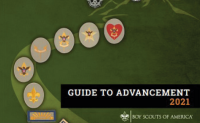 If you picked up Scouting magazine this month, you undoubtedly read the cover story about the National Geographic Channel’s reality-competition series Are You Tougher than a Boy Scout? which airs this spring. It pits current Scouts against adult former Scouts in tests of skill and strength typical of high-adventure activities.
If you picked up Scouting magazine this month, you undoubtedly read the cover story about the National Geographic Channel’s reality-competition series Are You Tougher than a Boy Scout? which airs this spring. It pits current Scouts against adult former Scouts in tests of skill and strength typical of high-adventure activities.
The article describes shooting the first day of competition, in which participants rappel down a cliff, jump into waiting whitewater rafts and navigate rushing rapids. As the story goes:
Once both teams are in their rafts, it’s not even close. The Scouts furiously steer their way through the rocks effortlessly, while the disorganized adults blunder along… “The whitewater rafting is a great example of how the teamwork and leadership of the Boy Scout movement comes into play. With rafting, you need a team that’s in sync and knows how to communicate and can execute the core ideals of the Boy Scouts — following directions and adding your input at the same time and working together to achieve a goal. The adults weren’t working the same way — they had three leaders and no followers, so they didn’t get anything done.”
I think their experience says something about the way boys lead. If adults try to lead them, we end up with a situation like the adults in the competition faced – too many leaders, each trying to direct in a different way, and nobody following and pitching in. The boys are supposed to be leading themselves, and if we inject our “leadership” into the mix, the boys’ leadership mission gets confused and muddied. They realize they should be making and carrying out these decisions themselves, but if adults are also telling them what to do (and undoubtedly in conflict with what they’ve planned), the end result is as messy as the hapless adults blundering their way down the rapids.
The takeaway from this contrast between the Scouts and adults in Tougher? is that given the opportunity to lead, the boys will do a great job – as long as the adults stay out of their way and don’t try to “improve” things by inserting themselves into the process. (Have you ever had a micromanaging boss? One who would second-guess every decision, every action of yours?)
Adult participation is essential, of course, but it has to be done the right way. The adult role in a troop is to train and mentor the youth leaders away from the troop meetings and outings, and the most important connection is between the Scoutmaster and the senior patrol leader. In an ideal troop, the more experienced boys will guide and train the others in skills and responsibilities, but not every troop works that way. Still, there is no reason for adults to hover over boys constantly. Just as the coach would not run out on the field during the game to tell the players what to do next, the adults do not get in the middle of the Scouts while their “game” is underway – their game being the troop meeting or campout. If you see something that needs to be brought to their attention, you do it behind the scenes – while meeting with the senior patrol leader after the troop meeting, for instance – not while the meeting is going on. Even something like “helping” the senior patrol leader call for order by hollering “Guys! Signs up!” undermines their confidence – it tells them that you don’t think they are capable of leading and can’t be trusted to even try it on their own.
So next time you think you are a “tougher” leader than your Scouts, think again. Let your Scouts lead, without crashing the raft into the rocks with your interference.
This post first appeared on Bobwhite Blather.



